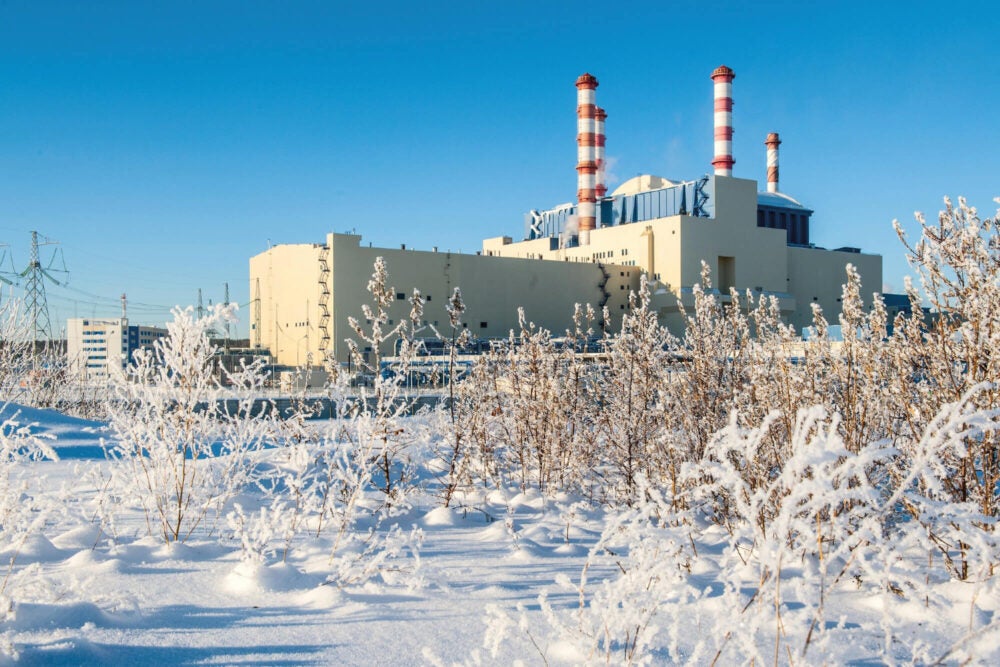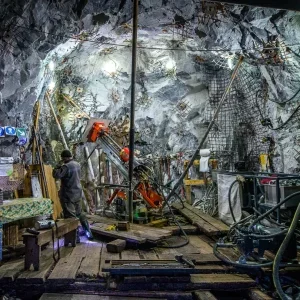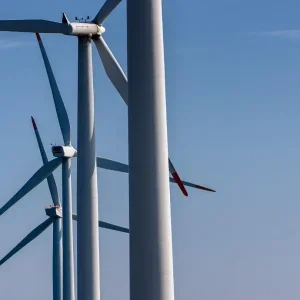
Over the past four years, Russian nuclear company Rosatom has made significant developments in nuclear fuel design. Here, Nuclear Engineering International’s Judith Perera reports on how the state-owned firm is developing new nuclear fuels.
In 2016, more than 250 specialists from more than 30 organisations attended a conference in Russia on new generation nuclear fuel for nuclear power plants (NPPs) – development, operating experience and future Directions.
The conference, organised by fuel company Tvel – which is part of the state nuclear corporation Rosatom – was held at the AA Bochvar Research Institute of Inorganic Materials (VNIIMN), a leading Russian centre for nuclear fuel research. It covered current developments recommended for a series of R&D directions for the development of new nuclear fuel.
“Today we are working in several key areas in the development and improvement of fuel for NPPs,” Pyotr Lavrenyuk, Tvel’s senior vice-president for scientific and technical activities, technology and quality control told the delegates.
“First of all, Tvel continues to improve VVER reactors, and improve the quality of zirconium materials. Next year we will focus on developing fast reactor fuel. Rosatom has set an ambitious goal for us to significantly increase the operating time and the percentage of fuel burnout.”
The conference agreed a range of work to improve nuclear fuel, including R&D-based on TVSA-PLUS and TVS-2M assemblies for NPPs with VVER-1000 reactors to ensure reliable operation in 18-month fuel cycles at up to 107% of nominal power, as well as refinement of the calculated neutron-physical parameters for VVER-440 and VVER-1000 cores to justify the supply of fuel and the safety of its operation. Much of this work has now been completed.
For example, in June 2020 Rosatom’ OKB Gidropress (part of Atomenergomash) began testing third-generation RK3+ nuclear fuel for VVER-440s developed for the Czech Republic’s Dukovany NPP under a contract signed with power utility CEZ in 2019. The new design improves the physical and thermo-hydraulic characteristics of the fuel.
“The introduction of RK3+ will create an opportunity for the operation of power units at increased thermal power and increase the duration of the fuel cycle of the Dukovany NPP, which will increase the economic efficiency of the plant,” said Alexander Ugryumov, vice-president for scientific and technical activities at Tvel.

The RK3+ has a longer fuel rod pitch that streamlines the water-uranium ratio in the reactor core and increases the efficiency of the fuel, Tvel said. The aim of the tests is to study the mechanical stability of fuel components under thermal-hydraulic and dynamic conditions, which are close as possible to full-scale operation.
Russia is also developing TVS-2M accident tolerant fuel (ATF) for use in both VVER and Western-design pressurised water reactors (PWRs). The first ATF fuel assemblies for the VVER-1000 reactor were manufactured and passed acceptance tests at the Novosibirsk Chemical Concentrates Plant (NCCP) in December 2019.
Rosatom plans to load three experimental ATF assemblies into one of the reactors of the Rostov NPP in 2020. Each assembly contains 12 fuel elements with two different cladding material options – either from a chromium-coated zirconium alloy or a 42KhNM chromium-nickel alloy. Both options make the cladding more heat-resistant.
Earlier in 2019, Rosatom completed the first phase of reactor tests. Two experimental fuel assemblies with VVER and PWR fuel elements were irradiated in separate water loops of the MIR reactor at the Research Institute of Atomic Reactors (NIIAR) in Dimitrovgrad.
Each consisted of 24 fuel elements with four different combinations of cladding materials and fuel composition. Fuel pellets were made from traditional uranium dioxide, as well as a uranium-molybdenum alloy with increased density and thermal conductivity. Then, several fuel elements from each fuel cassette were removed for further post-irradiated material science studies, and new non-irradiated samples were installed instead.
The full-size chromium-nickel alloy cladding was manufactured at Mashinostroitelny Zavod (MSZ) in Elektrostal; chrome plating was applied to standard zirconium claddings produced by the Chepetsk Mechanical Plant (ChMP) in Glazov by specialists from the National Research University – Moscow Power Engineering Institute (NRU MPEI).
R&D on ATF is carried out and coordinated by VNIINM. The introduction of ATF is of key importance for bringing the systemic safety and reliability of nuclear power to a qualitatively new level, said Tvel. Ugryumov said Tvel had “fulfilled all plans for the tolerant fuel programme for 2019 on time”.
Remix and MOX the latest developments in nuclear fuel design
At the 2016 conference, a separate decision was made to develop and improve technical documentation for fuel elements and fuel assemblies of various types, as well as structural materials, nuclear fuel and its components. The resolution paid particular attention to the development of new promising types of fuel, including Remix (regenerated mixture), Mox (mixed uranium-plutonium oxide), and MNUP (mixed nitride uranium-plutonium) fuel.
A project on the computational and experimental substantiation of Remix fuel was launched in 2014 involving a number of Russian enterprises under the leadership of the VG Khlopin Radium Institute in St Petersburg. Others included nuclear utility Rosenergoatom, a number of Tvel, NIIAR, OKB Gidropress and the Kurchatov Institute.
Remix, intended for use in VVERs, is obtained from an undivided mixture of regenerated uranium and plutonium, which is formed during the reprocessing of used nuclear fuel. An amount of enriched uranium is added to the separated mixture. In this way, the plutonium contained in the used fuel is reused as well as the unburnt uranium-235.
Once in widespread use, it is expected to reduce the consumption of natural uranium in the nuclear power industry. From the point of view of safety, Remix is no different from uranium dioxide with a maximum enrichment of 5%. The strategic objective is to close the nuclear fuel cycle.
In May 2016, the chemical and metallurgical plant at the Siberian Chemical Combine (SCC – part of the Tvel) in Seversk manufactured fuel rods containing Remix fuel, three of which were then loaded into unit 3 of the Balakovo NPP for extended testing. Others were sent to NIIAR for testing and further research.
Evgeny Lachkanov, head of the project for the creation of experimental and pilot industrial production of dense fuel at SCC, explained that the aim of Remix is to separate uranium and plutonium together in a mixture from thermal reactor used fuel. The mixture, after being purified from actinides and fission products, is then returned back to the nuclear fuel cycle with the addition of a calculated amount of uranium.
The tests at NIIAR, which took place between September 2016 and March 2017, were intended to obtain initial experimental data on the parameters of the operation of fuel elements. This data was needed to confirm the correctness of the choice of design criteria for VVER-1000 fuel assemblies.
The three Remix assemblies loaded into Balakovo 3 in July each contained six fuel elements. Pilot operation continued during 2020.
In 2021 they will be removed and transfered to the holding pool for one-and-a-half years before being delivered to NIIAR in 2023 for further research.
Vladimir Dergachev, head of the nuclear safety and reliability department at Balakovo NPP said the neutron spectrum of Remix fuel does not differ from that of ordinary uranium fuel. “This means that it can be used in conventional reactors without making additional changes to their design and additional safety measures – another indisputable advantage of the new fuel.”

In March 2019, scientists at the Mining and Chemical Combine (MCC) in Krasnoyark developed a new technology for producing both Remix and mox fuel. The new method differs significantly from the traditional one in that it makes it possible to obtain a master mixture suitable for further production of fuel pellets at the stage of reprocessing.
In this case, the mixture is obtained in the form of a solid solution, which ensures the maximum possible homogenisation parameters, MCC said. In industrial application, this drastically reduces the amount of liquids to be handled by recycling the mother liquor and significantly reduces labour and energy costs.
The new technology is simpler and quicker, and also makes it possible to abandon the use of hydrogen and ammonia in the technological chain. It also has a high level of compliance with the nonproliferation regime.
“The technology makes it possible to obtain a stoichiometric uranium dioxide or a mixture of uranium and plutonium dioxides in any nuclear safe ratio at the request of the customer,” MCC noted. This technology has already been used to manufacture mox fuel pellets under experimental industrial conditions.
“It should be recalled that mox fuel appeared as a result of an agreement signed with the US in 2000 on the disposal of military plutonium,” explained Evgeny Adamov, the scientific supervisor of the Proryv (Breakthrough) project, which aims to close the nuclear fuel cycle in Russia.
“We did not have any uranium-plutonium fuel at that time, but it was already used in the world. The French have used it in their fast reactors since 1967.” However, at that time, Russia’s fast reactors used uranium oxide. “We saw no sense in mox fuel for either thermal reactors or fast reactors, but there was no other mixed fuel in the world, and the agreement had to be implemented. It was assumed that Western countries would not only transfer technology to us, but also allocate subsidies of more than $3bn.”
In the event, the subsidies were not forthcoming, but Russia still went ahead with mox development in line with the agreement, Adamov said. By the time the USA cancelled its own mox programme in 2018, Russia’s mox development was well advanced.
Russia’s federal target programme (FTP), “Nuclear Energy Technologies of a New Generation for the Period of 2010–2015 and for the Perspective until 2020”, originally had not prioritised mox development or fast reactors, he said.
“Only in 2011 did they realise the expediency of consolidated work on closing the nuclear fuel cycle based on fast reactors. Then, significant funds were allocated to complete work on the production of mox fuel in view of the planned launch of the BN-800.” The concept of the Proryv project subsequently became part of the FTP in 2013.
Pilot being built at SCC to demonstrate the feasibility of a closed fuel cycle
As part of the breakthrough project, a Pilot Demonstration Energy Complex (ODEK) is being built at SCC, with the aim of demonstrating the feasibility of a closed fuel cycle. The ultimate aim is to eliminate production of radioactive waste from nuclear power generation.
ODEK will include three linked facilities, making up a closed nuclear fuel cycle at one site – a fuel fabrication/re-fabrication unit (FRU), a 300-megawatt (MW) nuclear power plant with the lead-cooled fast neutron BREST-OD-300 reactor, and a unit for used fuel reprocessing.
Proryv also includes continued development of mox fuel fabrication technology, which is based at MCC, and has a fuel production line located 200 metres underground. Russia’s mox is manufactured using depleted uranium and plutonium.
The raw materials for the production of mox fuel pellets are plutonium oxide produced in power reactors and depleted uranium oxide, which is produced from treatment of depleted uranium hexafluoride (DUHF), the secondary tailings of the enrichment process.
Rosatom’s long-term strategy is for a two-component nuclear power industry with thermal and fast reactors based on a closed fuel cycle. This will increase the resource base of the nuclear power industry, reuse used nuclear fuel instead of storing it, and utilise DUHF stocks accumulated in warehouses. The industrial fabrication of mox at MCC began at the end of 2018.
The 789 MWe BN-800 sodium-cooled fast reactor was first brought to minimum controlled power at unit 4 of the Beloyarsk NPP in June 2014, with commercial operation planned for the end of that year.
However, Rosenergoatom announced that the fuel needed to be developed further. The reactor was eventually connected to the grid in December 2015 and entered commercial operation in October 2016.
Initially, the BN-800 reactor had a hybrid core, comprising uranium fuel produced by MSZ in Elektrostal and experimental mox assemblies manufactured at NIIAR. The shift towards fully loading the BN-800 core with mox is scheduled for early 2022, Tvel said. MCC completed manufacture of the first full reload of mox for Beloyarsk 4 in July 2020.
A different kind of mixed uranium-plutonium fuel is being developed for production at the ODEK complex at SCC – dense mixed nitride uranium-plutonium (MNUP) fuel for use in the BREST-OD-300 reactor and also more widely for use in other fast reactors.
VNIINM is the responsible centre for the MNUP fuel element, assembly and fabrication technologies development, working with SCC, NIIAR and the VI Vernadsky Institute of Geochemistry and Analytical Chemistry of the Russian Academy of Sciences (GEOKhI RAS). VNIINM and SCC have developed the technology for producing mixed uranium-plutonium nitride fuel from powders of mixed actinide oxides.

Two batches of 1 kg of uranium-cerium oxide and uranium dioxide powder were produced, from which nitrides were then synthesised and fuel pellets made. Cerium is used as a plutonium simulator.
At the same time, laboratory batches of powders of mixed uranium and plutonium oxides were obtained at NIIAR working with GEOKhI RAS, for testing the technology for producing mixed uranium-plutonium nitride fuel from regenerated materials. These studies enabled development of the technology needed to obtain refurbished powders for the production of MNUP fuel.
“We are confident that our integrated technology for obtaining initial powders from refurbished materials for the production of MNUP fuel is safe and efficient,” said Vladimir Kascheev, director of the scientific and technological department for handling irradiated nuclear fuel and radioactive waste at VNIINM. “This speaks of the theoretical possibility of transferring the technology to industry, since all our studies have confirmed this.”
To confirm the operability of fuel assemblies with mixed uranium-plutonium nitride fuel, experimental fuel assemblies (ETVS) were manufactured at SCC using components supplied by MSZ in Elektrostal.
These were then loaded into BN-600 fast reactor unit at Beloyarsk 3 for testing. VNIINM said in 2018 that it had carried out post-irradiation studies on the assemblies on the basis of which “specialists noted a positive dynamics of the characteristics of fuel elements due to progress in the development of technology”.
Extensive data was also obtained for experimental fuel assemblies with a full load of MNUP fuel containing prototypes of fuel elements for the planned the BN-1200 fast reactor with a cladding made of EK164 steel (ETVS-4) and the BREST-OD-300 reactor with a shell made of EP823 steel (ETVS-5). This is being used to further improve the fuel elements and assemblies.
As part of the Proryv project, it is planned to separate minor actinides – neptunium and americium – from radioactive waste and include them in the fuel matrix for burning in the reactor.
Creation of a experimental high-voltage electrical impulse compaction unit
In August 2019, VNIINM scientists and experts from the National Research Nuclear University Moscow Engineering Physics Institute (NRNU MEPhI) said they had created an experimental high-voltage electrical impulse compaction unit (VEIK) for the manufacture of MNUP-fuel pellets containing minor actinides (neptunium and americium).
VNIINM said the use of the VEIK method will significantly optimise and simplify the technological process of making the tablets.
“The main advantages of this method are that pressing and sintering operations are carried out simultaneously and at a high speed,” said VNIINM. “Under the pulsed action of an electric discharge and pressure, fuel pellets with a given density and geometric dimensions are obtained. This technology can significantly reduce production space, reduce energy consumption and simplify remote work with highly active materials.”
Due to the low thermochemical stability of americium nitrides and the high pressure of their vapours, the existing method of manufacturing MNUP fuel pellets (pressing and high-temperature sintering) means their evaporation from the fuel is possible, VNIINM explained. The developed VEIK method now makes it possible to obtain composite tablets containing minor actinides.
In January 2020, SCC completed acceptance tests of ETVS-22, ETVS-23 and ETVS-24 experimental fuel assemblies with MNUP fuel. The acceptance committee was chaired by Alexey Glushenkov, chief expert at VNIINM, and included representatives from SCC, Tvel, OKBM Afrikantov, the Nikiet as well as Zarubezhatomenergostroy and Proryv. \
Zarubezhatomenergostroy provides technical acceptance of nuclear fuel and assesses the compliance of equipment, devices and materials for nuclear power plants, including those abroad.
Rosatom said the experimental fuel was manufactured using technology “as close as possible” to the industrial design, which will be used for the fabrication and re-fabrication module of the pilot demonstration energy complex under the Proryv project. Four fuel rods equipped with “bevelled tablets” were installed in each fuel assembly. Further reactor tests of the experimental fuel assemblies are planned at Beloyarsk.
In June 2020, Vyacheslav Pershukov, Rosatom’s special representative for international and scientific and technical projects and the head of the Proryv project, said reactor tests had confirmed the safety of the MNUP fuel. “The tests of the experimental batches are going well – more than 1000 fuel rods have been irradiated, with more than 8% burn up, and no cases of depressurisation,” he affirmed.
This confirms that the integrity of the shell of the fuel elements has been maintained. “In principle, we are ready to provide MNUP fuel for the programme for justifying fast reactors of any design,” he said.
This article first appeared in Nuclear Engineering International magazine






